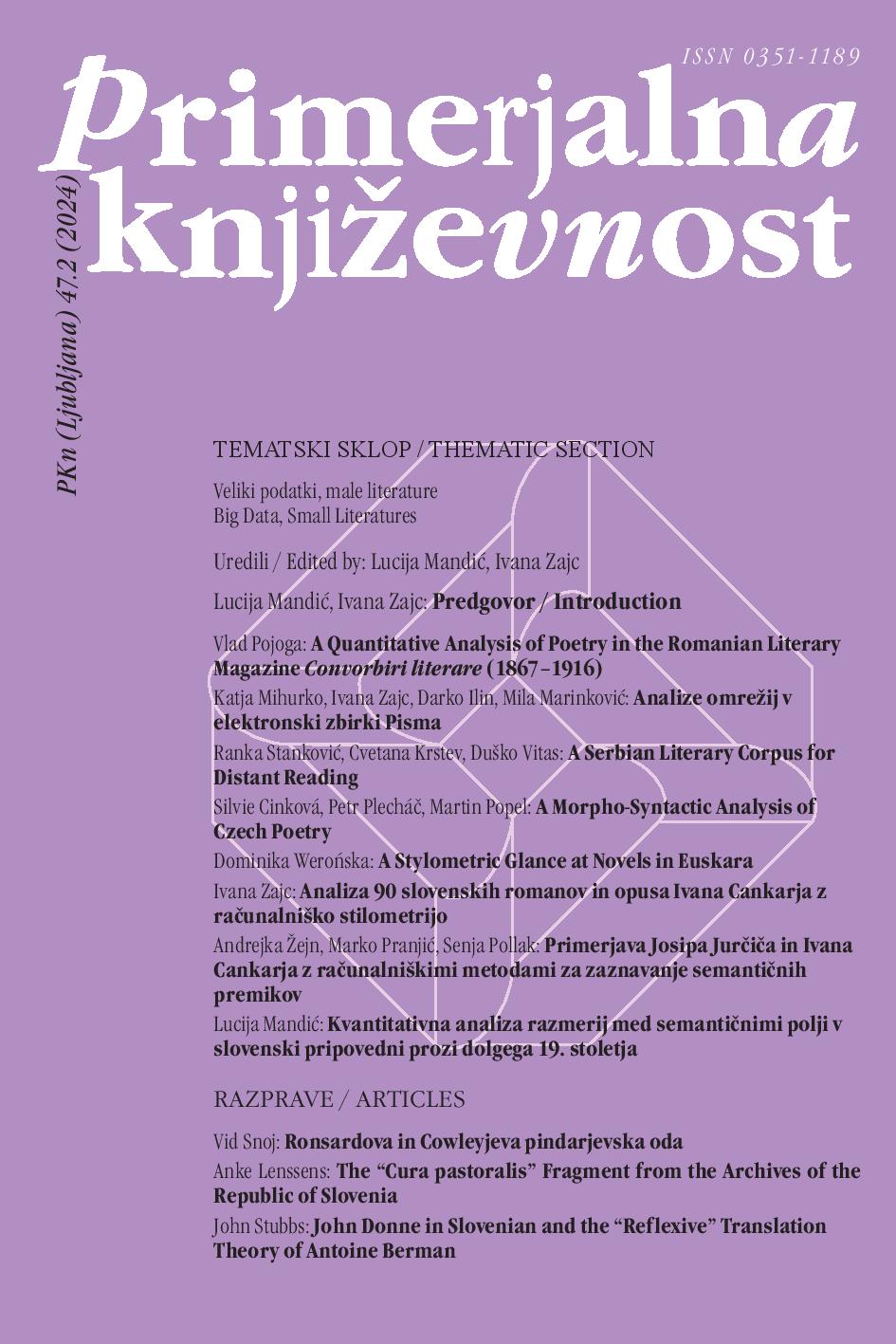A Stylometric Glance at Novels in Euskara
DOI:
https://doi.org/10.3986/pkn.v47.i2.05Keywords:
Basque literature, Euskara, text corpora, cluster analysis, stylometric mapAbstract
While Basque has been posited as possibly the oldest existing language on the European continent, it appears in written form only in the sixteenth century. The first Basque novel emerges over 300 years later and to this day the genre lacks exhaustive research. The article sets as its aim a stylometric analysis of selected twentieth- and twenty-first-century Basque novels, sourced from the online platforms Armiarma and Booktegi. These are analyzed based on the frequency of the most frequent words measured using cluster analysis and set against a backdrop of foreign novels translated into Euskara. The results show that the originals in Euskara remain distinct from translated works, pointing to the unique linguistic character of the Basque novel. Some linguistic patterns potentially responsible for this distinction are presented. The results are visualized on a map revealing the chronological evolution and the contribution of the Basque novel to the broader literary landscape.
References
Bastian, Mathieu, et al. “Gephi: An Open Source Software for Exploring and Manipulating Networks.” Proceedings of the International AAAI Conference on Weblogs and Social Media, vol. 3, no. 1, 2009, pp. 361–362.
Benzine, Vittoria. “The Earliest Words Ever Written in Basque Have Been Found Engraved on a Revelatory 2,100-Year-Old Bronze Relic.” Artnet News, 15 November 2022, news.artnet.com/art-world/hand-of-irulegi-earliest-basque-scriptnavarre-spain-2210963. Accessed 9 January 2024.
Brooks, Cleanth. William Faulkner: The Yoknapatawpha Country. LSU P, 1989.
Bulson, Eric. Novels, Maps, Modernity: The Spatial Imagination, 1850–2000. Routledge, 2017.
Collins, Roger. The Basques. Basil Blackwell, 1986.
Eder, Maciej. “Visualization in Stylometry: Cluster Analysis Using Networks.” Digital Scholarship in the Humanities, vol. 32, no. 1, 2017, pp. 50–64, https://academic.oup.com/dsh/article/32/1/50/2957386. Accessed 9 January 2024.
Eder, Maciej, and Jan Rybicki. “Do Birds of a Feather Really Flock Together, or How to Choose Training Samples for Authorship Attribution.” Literary and Linguistic Computing, vol. 28, no. 2, 2013, pp. 229–236.
Eder, Maciej, et al. “Stylometry with R: A Package for Computational Text Analysis.” The R Journal, vol. 8, no. 1, 2016, pp. 107–121, https://journal.r-project.org/archive/2016/RJ-2016-007/index.html. Accessed 9 January 2024.
Egurtzegi, Ander. “Metathesis of Aspiration as the Source of Anticipatory Voicelessness in Basque.” Journal of French Language Studies, vol. 29, no. 2, 2019, pp. 265–279.
Evert, Stefan, et al. “Towards a Better Understanding of Burrows’s Delta in Literary Authorship Attribution.” Proceedings of NAACL-HLT Fourth Workshop on Computational Linguistics for Literature, edited by Anna Feldman et al., Kerrville (TX), The Association for Computational Linguistics, 2015, pp. 79–88, https://aclanthology.org/W15-0709/. Accessed 9 January 2024.
Jansen, Wim. Beginner’s Basque. Hippocrene Books, 2007.
Juvan, Marko. Worlding a Peripheral Literature. Palgrave Macmillan, 2019.
Kurlansky, Mark. The Basque History of the World. Penguin, 2001.
Lasagabaster, Jesús María. “Introduction: Basque Literary History.” Basque Literary History, edited by Mari Jose Olaziregi, translated by Amaia Gabantxo, Center for Basque Studies, University of Nevada, 2012, pp. 13–21.
Larramendi, Manuel de. De la antiguedad y universalidad del bascuenze en Espaņa: de sus perfecciones y ventajas sobre otras muchas lenguas. Vol. 1, Por Eugenio Garcia de Honorato, 1728.
Michelena, Luis. “Lengua común y dialectos vascos. Berrarg.” Obras completas, vol. 7, edited by Joseba A. Lakarra and Íñigo Ruiz Arzalluz, Universidad del País Vasco, 1981, pp. 291–313.
Moretti, Franco. Graphs, Maps, Trees: Abstract Models for a Literary History. Verso, 2005.
Mukarovsky, Hans G. “Outline of a Lexicostatistical Study of Basque and the Mande Languages, with a Note on Fula.” Euskalarien nazioarteko jardunaldiak, Bilbao, Euskaltzaindia, 1981, pp. 199–212, https://www.euskaltzaindia.eus/dok/ikerbilduma/6777.pdf. Accessed 9 January 2024.
Olaziregi, Mari Jose. “Worlds of Fiction: An Introduction to Basque Narrative.” Basque Literary History, edited by Mari Jose Olaziregi, translated by Amaia Gabantxo, Center for Basque Studies, University of Nevada, 2012, pp. 137–200.
Pennebaker, James W. The Secret Life of Pronouns. Bloomsbury, 2011.
Rask, Rasmus. Investigation of the Origin of the Old Norse or Icelandic Language. Translated by Niels Ege, John Benjamins, 2013.
Rybicki, Jan. “A Second Glance at a Stylometric Map of Polish Literature.” Forum Poetyki, no. 10, 2017, pp. 6–21, http://fp.amu.edu.pl/a-second-glance-at-a-stylometric-map-of-polish-literature/#sdfootnote1sym. Accessed 9 January 2024.
Rybicki, Jan. “Pierwszy rzut oka na stylometryczną mapę literatury polskiej.” Teksty Drugie, no. 2, 2014, pp. 106–128.
Rybicki, Jan. “Stylometric Translator Attribution.” The Translator and the Computer, edited by Tadeusz Piotrowski and Łukasz Grabowski, Wydawnictwo Wyższej Szkoły Filologicznej we Wrocławiu, 2013, pp. 193–204.
Trask, R. L. The History of Basque. Routledge, 1997.
Trask, R. L. “Origins and Relatives of the Basque Language: Review of the Evidence.” Towards a History of the Basque Language, edited by José Ignacio Hualde et al., John Benjamins, 1995, pp. 65–100.
Vennemann, Theo. Europa Vasconica – Europa Semitica. Edited by Patrizia Noel Aziz Hanna, de Gruyter, 2003.
Zuazo, Koldo. Euskalkiak, herriaren lekukoak. Donostia, Elkar, 2003.


